The Adventurous Story Behind the SS Central America Gold Coins
Posted on — Leave a commentThe SS Central America played a pivotal role in U.S. history by sparking the Panic of 1857, widely recognized as the first global financial crisis. Dubbed the “Ship of Gold” for the immense quantity of precious metals it carried, ranging from coins to ingots, the vessel’s tragic sinking had far-reaching effects that shaped the nation’s future. This article will discuss the recovery of the vessel’s lost treasure, focusing on SS Central America coins and highlighting:
- The most interesting SS Central America facts
- The highest-value coins from the SS Central America shipwreck
- Where to buy SS Central America coins and other rare pieces
Learn more about the SS Central America gold recovery operation in this fascinating video:
Facts about S.S. Central America, known as the ship of gold
While most people associate this iconic vessel with the economic crisis sparked by the loss of its significant SS Central America gold value, there’s far more to its story, including important facts from before and after it was wrecked. Here, we outline some of the most compelling ones.
S.S. Central America size
Built by the renowned Webb shipyard, the SS Central America was a large steamship with a 40-foot beam and a length of approximately 280 feet. It had a gross tonnage of around 2,141 tons, reflecting its significant capacity, which allowed it to carry substantial cargo and numerous passengers across the Atlantic.
SS Central America route
The SS Central America regularly sailed between the East Coast of the United States and Central America. The ship’s typical route was integrated into a wider transportation network designed to support and manage the increased travel and trade associated with the gold rush. On the day of its sinking, the SS Central America was on a voyage from Aspinwall (now Colón), Panama to New York City via Havana, Cuba.
SS Central America shipwreck location
The exact SS Central America location remained unknown until it was discovered in 1988, despite extensive searches and speculation about its position. The ship was found on the Atlantic floor near the western edge of the Gulf Stream, approximately 160 miles east of Charleston, off the coast of South Carolina.
SS Central America wreck depth
The SS Central America depth is approximately 2,200 meters (about 7,200 feet) on the Atlantic Ocean floor. This significant depth places it well below typical recreational diving limits, requiring advanced deep-sea exploration technology to reach and investigate the site.
SS Central America wreck photos
The SS Central America recovery mission has been thoroughly documented. Photos from SS Central America taken by the recovery team reveal detailed views of the artifacts and wreck site.
Interestingly, in addition to the precious metals and coins found on the shipwreck, actual photographs were also discovered. These include daguerreotypes and ambrotypes, i.e. early photographic methods using metal and glass plates, respectively. Remarkably preserved due to their protective cases and the ocean floor’s cool, dark conditions, these images feature miners, families, and passengers, offering a poignant glimpse into the lives aboard the ill-fated vessel. These photos were published for the first time in 2022.
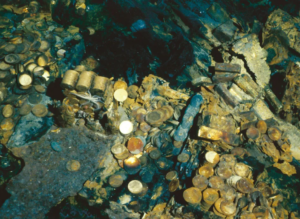
Photo by USA Today
SS Central America search
The SS Central America was located by the Columbus-America Discovery Group, led by Tommy Gregory Thompson, on September 12, 1988, using Bayesian search theory. A remotely operated vehicle (ROV) identified the wreck, and another ROV was used to recover significant amounts of gold and artifacts.
In March 2014, Odyssey Marine Exploration was contracted for the archaeological recovery and conservation of the remaining wreck. The “Odyssey Marine SS Central America” project aimed to explore and preserve the portions of the shipwreck that were not excavated during the initial recovery missions.
SS Central America survivors
When it went underwater, SS Central America became the site of one of the deadliest maritime disasters of the 19th century. Of the 578 people aboard the ship, over 400 lives were lost, including the captain and most of the crew.
Approximately 150 survived the sinking, including all the women and children. The survivors were mostly rescued by the steamship Mason after enduring the disaster. They faced challenging conditions in lifeboats and on makeshift rafts before being saved.
SS Central America coin inventory
The wreck of the SS Central America yielded approximately 10,000 coins, including thousands of freshly minted Double Eagles, and a variety of other rarities. Today, these coins are even more coveted than they were in their own time. SS Central America coins for sale are highly sought after by collectors for their allure as pre-1933 coins, prized for their historical significance and exceptional craftsmanship. Here, we highlight five of the most valuable coins discovered in the wreckage.
1. 1857-S $20 SS Central America coin
The 1857-S Double Eagle SS Central America coin is a notable numismatic treasure, particularly prized for its connection to the California Gold Rush. Struck at the San Francisco Mint, this coin features the Liberty Head design.
Approximately 5,400 of these freshly struck Double Eagles were recovered from the wreck, many in exceptional condition. Before this discovery, the finest examples of Type I Double Eagles from the San Francisco Mint were typically graded only in the AU range.
The 1857-S SS Central America coin’s high value today reflects its pristine condition and its unique place in American coinage history.
1857-S Liberty Head Double Eagle
- Metal: Gold
- Year: 1857
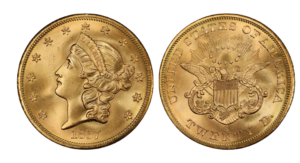
Photo by PCGS
2. 1854-O $2.50 S.S. Central America gold coin
The 1854-O Quarter Eagle is another remarkable piece among S.S. Central America shipwreck gold coins. Produced by the New Orleans Mint, this coin had a relatively high mintage of 153,000 pieces, making it a fairly common date.
However, what makes the 1854-O $2.50 coin from the SS Central America particularly special is its exceptional state of preservation. Coins from this era, especially those minted in New Orleans, often show considerable wear, but examples recovered from the wreck are in remarkably high grade, thanks to the protective environment of the ocean floor.
1854-O Liberty Head Quarter Eagle
- Metal: Gold
- Year: 1854

Photo by PCGS
3. 1852 $50 Humbert S.S. Central America gold coin
One of the most extraordinary S.S. Central America gold coins, this 1852 $50 gold piece is an octagonal ingot, also known as a “slug”. The coin’s large size and weight made it ideal for significant transactions during the Gold Rush, but it also led to many being melted down over the years, making surviving examples particularly scarce.
This hefty coin was the final piece minted by Augustus Humbert, the United States assayer of gold in California, which contributes to its status as a highly sought-after relic of the Gold Rush era. The coin’s reeded edge further distinguishes this piece from other Humbert $50 coins, adding to its desirability among collectors.
1852 Augustus Humbert $50 with Reeded Edge
- Metal: Gold
- Year: 1852
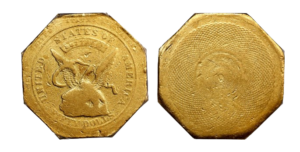
Photo by PCGS
4. 1847-O Half Dollar SS Central America treasure
The discoveries on the S.S. Central America wreck were not limited to gold. Collectors can also find numerous SS Central America silver coins for sale that are truly worth the investment.
A prime example is this 1847-O Liberty Seated Half Dollar. Minted in New Orleans, this coin is highly valued for its scarcity, with only a limited number of surviving examples. The exceptional preservation of these coins from the S.S. Central America makes them greatly desirable in numismatic circles, adding significant value and allure to any collection.
1847-O Liberty Seated Half Dollar
- Metal: Silver
- Year: 1847
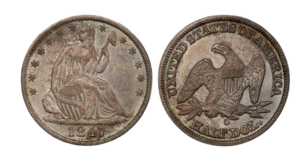
Photo by PCGS
5. One of the rare 1853 SS Central America dimes
Another silver S.S. Central America treasure is the 1853 Liberty Seated Arrows dime. This coin is notable for the arrowheads flanking the date, a design feature introduced that year to indicate a reduction in the coin’s weight due to rising silver prices. This change helped distinguish the newer, lighter coins from earlier versions, which were being melted down for their higher intrinsic value.
With a production run of over 12 million coins, this dime is widely available in most conditions, though top-grade examples, such as the ones from the S.S. Central America, are much rarer.
1853 Liberty Seated Arrows Dime
- Metal: Silver
- Year: 1853
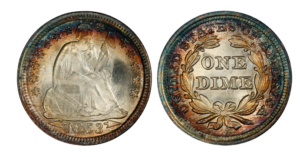
Photo by PCGS
To browse through rare coins beyond SS Central America inventory, click here.
Other SS Central America artifacts
In addition to the vast array of coins, the SS Central America shipwreck yielded numerous other significant gold artifacts. Among these were over 500 large gold bars, produced by assayers of the Gold Rush. Some SS Central America gold ingots were reported to weigh as much as 1,000 ounces.
The ship also carried hundreds of gold nuggets, weighing between 0.031 to 0.40 grams. These SS Central America gold nuggets were considered extremely valuable, as they represented a raw form of gold extracted from mining operations, capturing a direct link to the period’s mining endeavors.
Additionally, gold dust, which was collected from mining operations and stored in small containers, was found scattered among the wreckage.
The discovery of SS Central America gold dust, totaling approximately 36 kilograms, adds another layer of historical richness to the shipwreck, highlighting the extensive gold production and trade practices of the era.
FAQ about S.S. Central America coins
Here are the answers to people’s most common questions about SS Central America shipwreck coins.
Where did the SS Central America sink?
The SS Central America sank off the coast of South Carolina, approximately 160 miles east of Charleston.
How deep is the SS Central America?
The SS Central America lies approximately 2,200 meters (7,200 feet) deep on the Atlantic Ocean floor.
Who found the SS Central America?
The SS Central America was discovered by the Columbus-America Discovery Group led by Tommy Gregory Thompson in 1988.
How much gold was on the SS Central America?
The SS Central America carried an estimated 21 tons of gold, including coins, ingots, and dust, at the time of its sinking.
How much gold was recovered from the SS Central America?
The SS Central America gold recovery included over 7,000 gold coins, 800 ingots, and approximately 36 kilograms of gold dust.
Is there still gold on the SS Central America?
While significant amounts of gold were recovered from the SS Central America, estimates suggest that additional coins and artifacts might still be present in the wreck.
Gold from the SS Central America represents a remarkable chapter in numismatic history, with its exquisite coins and artifacts continuing to captivate collectors. For those interested in acquiring these rare pieces or exploring other exceptional numismatic opportunities, Blanchard is your premier resource. Renowned for its expertise and extensive inventory of rare coins, Blanchard offers unparalleled guidance and support. Whether you have questions about shipwreck coins, SS Central America or need advice on other numismatic investments, Blanchard’s knowledgeable team is always available to assist you.
Want to read more? Subscribe to the Blanchard Newsletter and get our tales from the vault, our favorite stories from around the world and the latest tangible assets news delivered to your inbox weekly.








